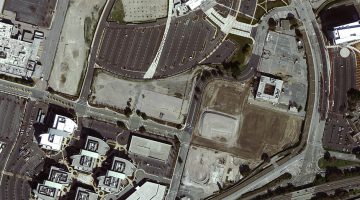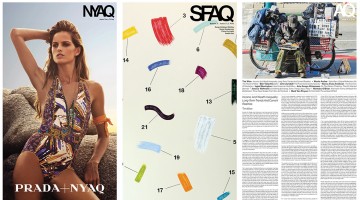Islands In The Stream: On Local Networks & Internet Freedom
If you could remake the Internet from scratch with all the knowledge of the current history of the Internet, what would it be like? What kind of communications would you want to create? What kind of services? What kind of scale would your Internet have?
These are not exactly the questions that come with Commotion Wireless’s Construction Kit, but they’re implicit in the process of trying to think through building a new, local network. Commotion, a project of the New America Foundation’s Open Technology Institute (OTI), is a free, open-source tool designed to help groups setup and maintain mesh networks without necessarily having in-depth technical knowledge. Articles and essays about local networks (like this one!) cite Commotion as an example pretty regularly, in part because it offers an undeniable use case: resilience in a crisis. OTI had worked with a community organization in Red Hook, Brooklyn, to set up a mesh network in the neighborhood (Red Hook WiFi). While not particularly utilized at first, the network proved incredibly valuable in the aftermath of Hurricane Sandy, acting as a local resource for information, and later as a gateway connecting the mesh to a satellite uplink provided by FEMA.
While the particular use case of a crisis response is an awesome reason to support localized infrastructure, I’m honestly more interested in how Red Hook WiFi provided hyper-local services to the neighborhood—the local network hosted an app surveying residents about their experiences with stop-and-frisk, and another provided real-time status updates on the B61, the primary bus line serving Red Hook. It’s great that Red Hook WiFi acts as a bridge to connect the neighborhood to the web, but it’s also a way to connect people in the area to each other, addressing policy issues and providing services.
Red Hook WiFi is a network that operates at a neighborhood scale, offering the option to connect to the worldwide scale. In contrast, Dan Phiffer’s occupy.here is both humbly and critically anti-scale. Initially prototyped during Occupy Wall Street, occupy.here is firmware that turns a single router into a small local area network (LAN—basically, a network of machines, near to one another, that can talk to each other but that aren’t connected to the web) hosting a simple forum application. Users can create handles or be anonymous, and can upload and add images and files to the forum. It’s been presented mostly in art contexts since Occupy, although I’ve tried it out as a hyper-local backchannel at conferences and Phiffer is interested in other applications for it.
What’s the purpose of a network that “connects” people who are less than a thousand feet apart? If two people are right next to each other, why not just communicate directly, face to face? Why would you have a forum application for people who are, if not a block apart, in the same room? In the context of Occupy Wall Street, the project had incredibly pragmatic applications. In a gallery, it’s not always clear what users are supposed to do. What would happen in a less formal context—a high school hallway, a hotel lobby, an apartment complex?
Somewhere between Phiffer’s super-local occupy.here and Red Hook WiFi might be projects like Aaron Straup Cope’s. Cope has an uncanny tendency for building things that serve needs people didn’t realize they had, in particular the need to be able to put our stuff somewhere. Recognizing that online platforms die and fail without necessarily offering backups, Cope began building things that hooked into platform infrastructure to provide exit strategies from them. Parallel-flickr takes a user’s Flickr login information and allows them to generate a backup of their Flickr account that honors their existing permission settings. Another project, PrivateSquare, allows a user the same check-in and sharing functionality of FourSquare with the option to push that information to FourSquare or keep it stored with the PrivateSquare instance. It turns a sharing platform into a place diary, subverting the network into an archive. Cope’s projects are a form of network-gleaning, using loose threads of the web to weave together a more personal and controllable experience.
At the heart of Commotion, occupy.here, and projects like PrivateSquare are questions also central to debates over surveillance and net neutrality. Who owns the infrastructure, and do/can we trust them? What, if anything, do the owners of infrastructure owe to their users? How much digital literacy should be required of a user, and to what extent is that expectation of literacy victim-blaming? We forget, at our own peril, how relatively new the net actually is. Humans are still learning how to live online, suspended in uneasy public-private protocols; the past two decades have made it more, not less confusing. The expectation of expertise assumes that expertise is even possible and encourages a particularly nasty strain of techno-libertarianism. To borrow an example from surveillance debates: the assumption held by some that deep knowledge of cryptography is a prerequisite for maintaining privacy online—and that those who don’t learn don’t “deserve” that privacy—also assumes everyone has the time, energy, and skills to learn it. Which, to parallel a real-life example, suggests that if you can’t treat a gunshot wound by yourself, you don’t deserve medical care. Do we all have to be able to configure and setup our own server racks to feel like we are using an Internet that’s ours?
Popular rallying cries of Internet activists these days speak to “taking back” and “resetting” the Internet. The implicit assumption in this framing is that the Internet used to be one way, and it’s not that way anymore because someone has damaged it—government agencies, giant ISPs, information infrastructure companies.
For those who might relate to this framing, there’s an understanding that the Internet used to be smaller—or, at least, it used to feel smaller. You could talk to lots of people online, but the circle of strangers you connected to was still personal, still meaningful. If strangers appeared, they were only occasionally monsters. The Weird Old Internet didn’t have algorithms filtering information to please you or hyper-targeted ads. The net that we’re supposedly “taking back” was, we’re led to believe, a more empathetic, human one.
It was also slow, difficult to use, and to some extent a far more homogeneous population expressing empathy with each other. It was a lot of weirdos, enthusiasts, hobbyists—many of whom were men, many of whom were white. (The writer and my friend Joanne McNeil has informally referred to this as “the Internet of dads,” a term that I hope is understood as a term of critical compassion—we love the dads who built the Internet the way a teenage girl loves and resents her dad, some of my best friends are dads, etc.). Parts of the Weird Old Internet were great, but it’s up for debate whether it was any safer for or accessible to the marginalized voices that have made the web such a galvanizing political force in the last few years.
My fear, then, when we talk about taking back the net is that we’re somehow also going back to a net that may have not existed, or may not have been as magical as we think it was. While I have my own fond, fuzzy memories of a Weird Old Internet of my own making, I don’t really believe that was everyone’s Internet, and I don’t really want that Internet back.
Going hyper-local won’t save the Internet from the machinations of Comcast, Google, or the State any more than a rhetorical “reset” will. A local network’s community is as self-selecting as the Weird Old Internet’s was. To suggest that we simply build new Internets in the face of the current one’s complexity and toxicity has its own risks, mainly of creating the kind of fiefdoms and walled gardens that the fight for net neutrality seeks to prevent. To some extent the local “offline” network risks creating more elite backchannels, now merely enforced by signal reach rather than social dynamics.
In the background of every contentious discussion of the future of the network is a tricky, sentimental thing: trust. People don’t really like to talk about trust when they talk about resetting or fixing the net, because right now, the technical fixes for trust at the network level are still somewhat rickety, opaque, and easily (and apparently frequently) betrayed. And, to some extent, the infrastructure is so massive that to default to distrust is to withdraw from the whole. We can’t build a new Internet; we can perhaps only pray that the tubes and pipes haven’t been corroded to their core. To default to trust, to offer trust, is a frightening thing in a fragile world. For all their shortcomings, perhaps the greatest value in smaller, localized network projects is working at a more human scale—one that allows for trust and accountability—than transatlantic cables or social networks. While small, local networks aren’t a panacea, I believe in their potential because I believe in people more than I believe in corporations or nation-states. As more groups experiment with localized networks, as we build more islands in the stream of the net, our archipelagos will also need strong, sturdy bridges.



